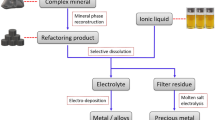Abstract
The chemistry of the aqueous environment inside any breached waste packages is critical to the release of radionuclides from the waste packages for high-level waste disposal. A corrosion test cell that simulates some aspects of the internal geometry of the waste packages has been designed to investigate changes in the in-package solution chemistry. A series of tests was conducted to evaluate solution chemistry variations as a function of applied potential and temperature using a specimen of Type 316L stainless steel with a predrilled hole as a simulated pit. A micro-syringe was used to extract solutions from inside and outside the pit. The solutions were analyzed for cation concentrations using capillary electrophoresis, and the pH was measured using a micro-electrode. Preliminary measurements showed substantially high cation concentrations inside the pit due to anodic dissolution of Type 316L stainless steel. The solution pH became considerably acidic, reaching a value of 2.6. These results suggest that interactions of waste package internal structural components with incoming water may have significant influence on the evolution of water chemistry and the subsequent corrosion of waste forms such as spent nuclear fuel.
Similar content being viewed by others
References
In-Package Chemistry for Waste forms, ANL–EBS–MD–000056. Revision 00. (CRWMS M&O, Las Vegas, NV, 2001).
T. Tsuru, K. Hashimoto, and S. Haruyama in Proceedings of Critical Issues in Reducing the Corrosion of Steels, edited by H. Leigheiser and S. Haruyama (NACE International, Houston, TX, 1985) pp. 110–120.
S. Brossia and R.G. Kelly in Critical Factors in Localized Corrosion II, edited by P.M. Natishan et al. (The Electrochemical Society, Pennington, NJ, 1996) pp. 201–217.
T.M. Suzuki, T.M. Yamabe, and Y. Kitamura, Corrosion 29, 18–22 (1973).
M.A. Cavanaugh, J.A. Kargol, J. Nickerson, and N.F. Fiore in Advances in Localized Corrosion. (NACE–9, NACE International, Houston, TX, 1983) pp. 144–150.
A. Alavi and R.A. Cottis, Corrosion Science 27, 443–451 (1987).
In-Drift Precipitation/Salts Analysis, ANL–EBS–MD–000045. Revision 00. ICN 02. (CRWMS M&O, Las Vegas, NV, 2001).
J.M. Krol, M. Benvenuti, and J. Romano, Ion Analysis Methods for IC and CIA® and Practical Aspects of Capillary Ion Analysis Theory, Waters Corporation, Milford, MA, 2000.
Author information
Authors and Affiliations
Rights and permissions
About this article
Cite this article
Pan, Y.M., Brossia, C.S., Cragnolino, G.A. et al. Evolution of Solution Chemistry through Interactions with Waste Package Internal Structural Components. MRS Online Proceedings Library 713, 110 (2001). https://doi.org/10.1557/PROC-713-JJ1.10
Published:
DOI: https://doi.org/10.1557/PROC-713-JJ1.10




